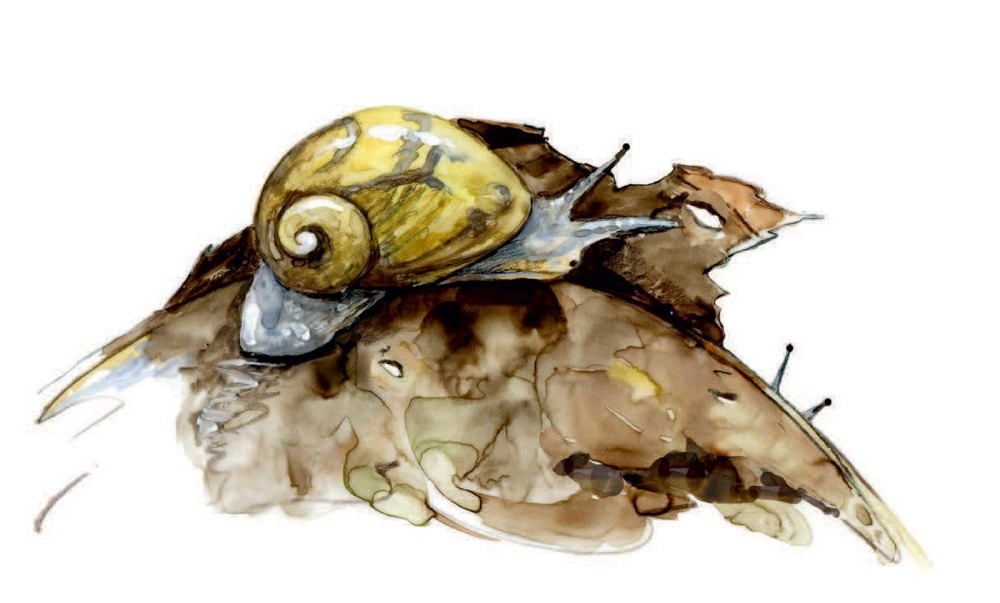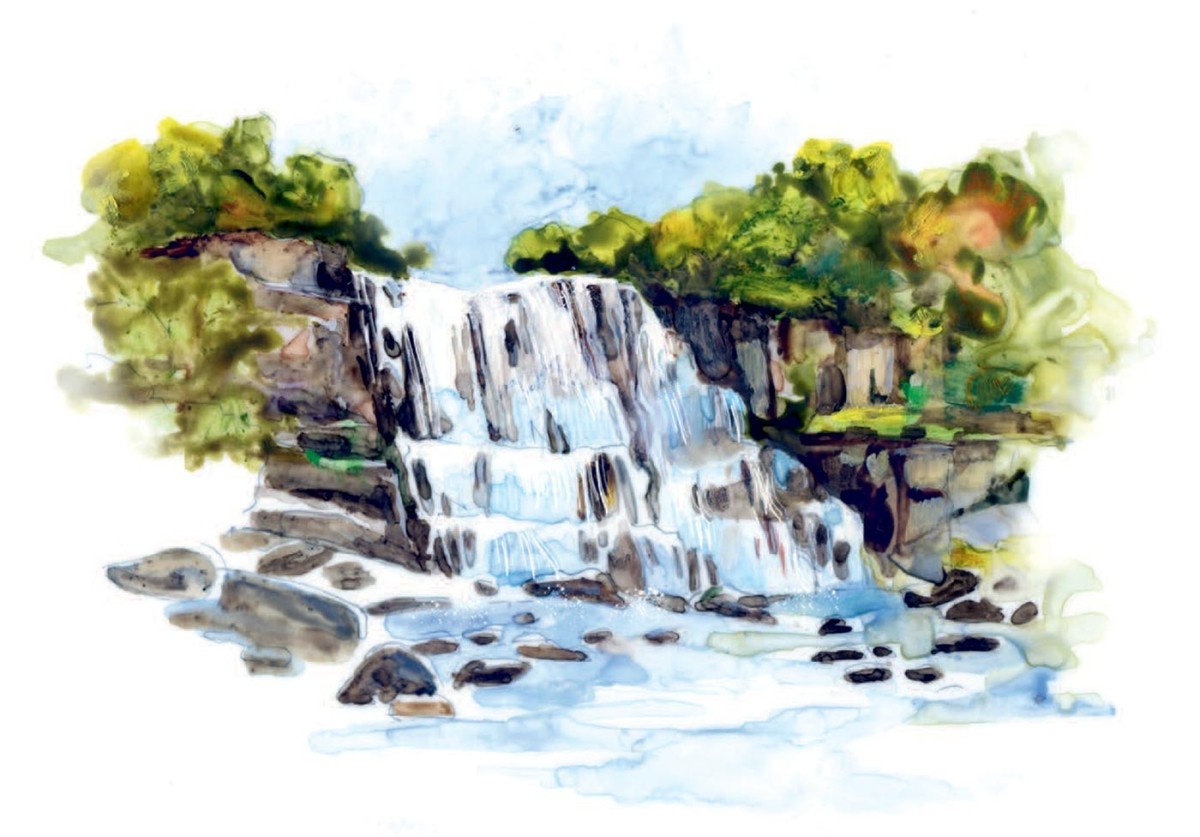
Intolerance of disturbance, specific habitat requirements, and narrow distribution: these are characteristics that threaten species with extinction. Unfortunately, the Chittenango ovate amber snail (Novisuccinea chittenangoensis) has all these traits.
Measuring around ¾ inch, the snail has a semitranslucent shell, through which you can see the mottled yellow, gray, and brown of its organs. Its head and tail are also semitranslucent, and you can look down through the top of its head and see its radula (chitinous, tooth-like scraper). This is a snail that stands out from the crowd – that is, if you ever see one. But perhaps the most important message I can send in this article is, please don’t try.
In 1905, a field party from The Academy of Natural Sciences at Philadelphia discovered the species during a visit to the Chittenango Falls in Madison County, New York. In the century since, no one has found the snail anywhere else. The Chittenango ovate’s entire habitat is the splash zone of the north-facing falls, which cascade 127 feet down steep limestone steps. The splash zone covers an area the size of an average living room.
Unfortunately, these scenic falls also annually attract upward of 45,000 human visitors, who may inadvertently put these snails at risk of a crushing end. A greater risk to their population, however, likely comes from competition for resources with other amber snail species, including an invasive snail that originated in Europe, Succinea putris. By some estimates, S. putris outnumbers the Chittenango ovate at a scale of 50 to 1 around the waterfall.
Conservation biologists are working hard to pull the Chittenango ovate back from the brink. Professor Rebecca Rundell at State University of New York College of Environmental Science and Forestry (SUNY ESF) has been maintaining a population of the threatened snails on campus since 2015, housing them in environmental chambers that control for such factors as humidity, temperature, and photoperiod. Great Lakes Restoration Initiative funds this work to improve the odds of survival for this critically endangered population.
Maintaining the lab population has been challenging. Despite its bestseller potential, a Chittenango Ovate Amber Snail Husbandry Manual does not exist, so Rundell and her students have had to figure out such basics as what to feed the snails, the snails’ preferred thermostat settings, and other details about the biology of these animals. They have divined all the protocols and procedures through trial and error.
The SUNY ESF team began raising their first captive population in 1995, but things did not go well, and that population ultimately failed. But starting in 2015, the “Snailblazers,” as the team calls itself, attempted a different approach. First, Cody Gilbertson, then a master’s student, raised the Chittenango ovate’s habitat competitor, Succinea putris, to establish techniques. Because this snail has moved into the same niche around the falls, it seemed likely that what was good for S. putris would be good for N. chittenangoensis. The Snailblazers gained important knowledge from this experience, including how to monitor snail health.
When threatened or resting, snails withdraw into their shells. How well they fit in their shells indicates body mass. Well-fed and hydrated snails fairly fill their shells. Only skinny and thirsty snails can withdraw deep into their shells, leaving empty space at the entrance. A skinny snail is an unhealthy snail, and an indicator that habitat conditions are not right.
Using this simple health indicator, the Snailblazers were able to proceed step by careful step in determining how best to care for S. putris. Food was the first consideration. The team presented snails with an array of materials from the habitat around the falls. Eventually they determined that the snails’ preferred food includes leaves from black cherry, fire cherry, pignut hickory, and sugar maple.
However, not just any leaves will do. The snails rejected fresh leaves, instead opting for leaves that had been lying on the ground for several months and had lost their protective waxy coatings. Old leaves may also be more palatable to the snails, because many of their toxic compounds have leached out. The snails were especially choosy about sugar maple leaves, eating only sun-bleached leaves of this species.
With protocols established, the team began raising Chittenango ovates. They brought small numbers into the lab, allowed them to reproduce, and then released them back into their natural habitat. Snails can produce 30 to 40 eggs at a time and reproduce several times during their 2½-year lifespan. The captive population grew from a handful of captured individuals to several hundred snails.
With a stable lab population established, the team developed a pyramid plan for release: they regularly released large numbers of egg masses, fewer juvenile snails, and still fewer adult snails into the original population site. In the past year, the Snailblazers also released captive-bred snails at two additional waterfall sites selected for their proximity and similarity to Chittenango Falls.
To give the snails a fighting chance in their new habitat, the team remove S. putris snails and also weed out pale swallowwort, an invasive plant that, left unchecked, tends to take over areas. Weeding the swallowwort, however, is a tedious process because every stalk, root, and leaf must be checked for young, tiny Chittenango ovate snails before the Snailblazers can discard the plants. State park staff have also fenced and sign-posted the habitat in an effort to reduce foot traffic.
I take heart from the collective efforts of the Snailblazers to drag this one species back from the brink. According to Gilbertson, who now serves as the senior research support specialist on the team, 42 percent of recent extinctions have involved molluscan species, and of those species, 99 percent have been terrestrial. Protecting the Chittenango ovate amber snail is a mission that’s important in its own right, but the techniques and approaches developed at SUNY ESF will also have broader importance, if they can help conservationists save other endangered snails. I hope to write about these snails 10 years from now and report that three populations thrive below three different Madison County waterfalls. If that happens, we’ll all have the Snailblazers to thank!


